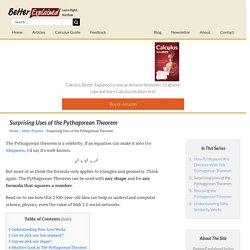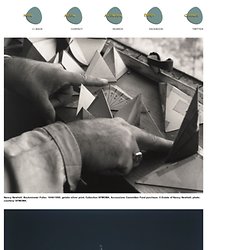

Angles. What Is The Importance Of Triangles In Our Daily Life. Triangles feature in a number of aspects of our daily lives, including mathematics, engineering, architecture, astronomy, and even music.Triangles in mathematicsTriangles feature very frequently in the discipline of mathematics.

For example, almost all two dimensional shapes (apart from a circle) can be made up of a series of triangles arranged in a certain way. Furthermore, in the field of mathematics, triangle-related formulae such as Pythagoras' theorem (a^2+b^2=c^2) form the basis of a great deal higher levels of mathematical education, in branches such as trigonometry.Triangles in engineering and architectureAs mentioned above, Pythagoras' theorem is an incredibly important theory.
However, its importance goes beyond the field of pure mathematics and spans other fields including engineering and architecture. Surprising Uses of the Pythagorean Theorem. The Pythagorean theorem is a celebrity: if an equation can make it into the Simpsons, I'd say it's well-known.

But most of us think the formula only applies to triangles and geometry. Think again. The Pythagorean Theorem can be used with any shape and for any formula that squares a number. Read on to see how this 2500-year-old idea can help us understand computer science, physics, even the value of Web 2.0 social networks. Understanding How Area Works I love seeing old topics in a new light and discovering the depth there. The area of any shape can be computed from any line segment squared.
We can pick any line segment and figure out area from it: every line segment has an "area factor" in this universal equation: For example, look at the diagonal of a square ("d"). Now, use the entire perimeter ("p") as the line segment. Can we pick any line segment? You bet. Can we pick any shape? Sort of. Yes, every triangle follows the rule "area = 1/2 base * height". Cool, huh? Makes sense, right?
Similartriangles3 [licensed for non-commercial use only] / Applying Similar Triangles to the Real World. Similar triangles can be used for many different things.
![similartriangles3 [licensed for non-commercial use only] / Applying Similar Triangles to the Real World](http://cdn.pearltrees.com/s/pic/th/similartriangles3-commercial-44566627)
In architecture similar triangles are used to represent doors and how far they swing open. Also when you use shadows that make triangles to find the height of an object. You can use that find the height of actual objects and they can also be used to stabilize a bridge. Cedric R. Similar triangles can be used for many different things. 2-11-10 8:00 You can use similar triangles for a variety of things. This is a ramp Alhosainy A 2/13/2010 11:43 Alhosainy A 2/13/2010 11:43 Similar triangles can be used to find the length or height of certain things. "Find the value of the height, h m, in the following diagram at which the tennis ball must be hit so that it will just pass over the net and land 6 meters away from the base of the net Chirag T. triangle O1G1D1 is similar to triangle O2G2D2 By: CHRISTIAN.
APPLICATIONS OF MATHEMATICS IN OUR DAILY LIFE. Geometry Proofs - How To Information. Real Life Uses of the Pythagorean Theorem. Architecturebuckminsterfuller. Marta Herford Goebenstraße 4-10 + 49(0)52 21-99 44 30-0 Herford Bucky Fuller & Spaceship Earth June 11-September 18, 2011 Born in 1895 into a distinguished family of Massachusetts, which included his great aunt Margaret Fuller, a feminist and writer linked with transcendentalist circles of Emerson and Thoreau, Richard Buckminster Fuller Jr. left Harvard University, where the Fuller men had studied since 1740, to become an autodidact and earn a living by doing odd jobs.

After marrying Anne Hewlett and serving in the Navy during World War I, he worked for his architect father-in-law at a company that manufactured reinforced bricks. The company went under in 1927, and Fuller set out on a year of isolation and solitude, during which time he nurtured many of his ideas — such as four-dimensional thinking (including time), which he dubbed 4D — and the search for maximum human benefit with minimum use of energy and materials using design.